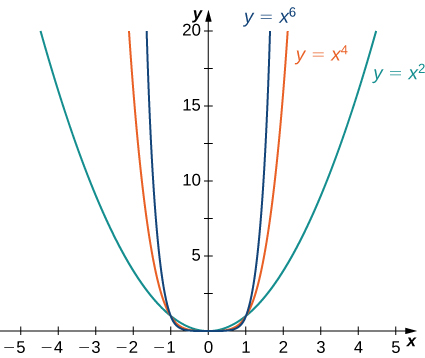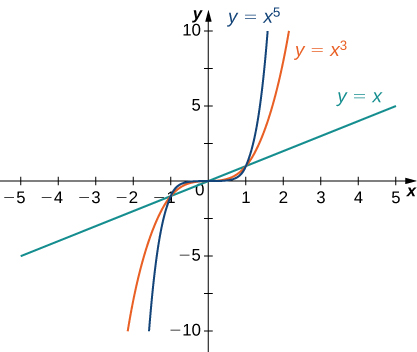End Behavior
The behavior of a function as [latex]x\to \pm \infty[/latex] is called the function’s end behavior. At each of the function’s ends, the function could exhibit one of the following types of behavior:
- The function [latex]f(x)[/latex] approaches a horizontal asymptote [latex]y=L[/latex].
- The function [latex]f(x)\to \infty[/latex] or [latex]f(x)\to −\infty[/latex].
- The function does not approach a finite limit, nor does it approach [latex]\infty[/latex] or [latex]−\infty[/latex]. In this case, the function may have some oscillatory behavior.
Let’s consider several classes of functions here and look at the different types of end behaviors for these functions.
End Behavior for Polynomial Functions
Consider the power function [latex]f(x)=x^n[/latex] where [latex]n[/latex] is a positive integer. From Figure 11 and Figure 12, we see that,
and,


Using these facts, it is not difficult to evaluate [latex]\underset{x\to \infty }{\lim}cx^n[/latex] and [latex]\underset{x\to −\infty }{\lim}cx^n[/latex], where [latex]c[/latex] is any constant and [latex]n[/latex] is a positive integer.
evaluating limits of power functions
If [latex]c>0[/latex], the graph of [latex]y=cx^n[/latex] is a vertical stretch or compression of [latex]y=x^n[/latex], and therefore,
If [latex]c<0[/latex], the graph of [latex]y=cx^n[/latex] is a vertical stretch or compression combined with a reflection about the [latex]x[/latex]-axis, and therefore,
If [latex]c=0, \, y=cx^n=0[/latex], in which case [latex]\underset{x\to \infty }{\lim}cx^n=0=\underset{x\to −\infty }{\lim}cx^n[/latex].
For each function [latex]f[/latex], evaluate [latex]\underset{x\to \infty }{\lim}f(x)[/latex] and [latex]\underset{x\to −\infty }{\lim}f(x)[/latex].
- [latex]f(x)=-5x^3[/latex]
- [latex]f(x)=2x^4[/latex]
We now look at how the limits at infinity for power functions can be used to determine [latex]\underset{x\to \pm \infty }{\lim}f(x)[/latex] for any polynomial function [latex]f[/latex].
Consider a polynomial function
of degree [latex]n \ge 1[/latex] so that [latex]a_n \ne 0[/latex]. Factoring, we see that,
As [latex]x\to \pm \infty[/latex], all the terms inside the parentheses approach zero except the first term. We conclude that,
The function [latex]f(x)=5x^3-3x^2+4[/latex] behaves like [latex]g(x)=5x^3[/latex] as [latex]x\to \pm \infty[/latex] as shown below.

| [latex]x[/latex] | [latex]10[/latex] | [latex]100[/latex] | [latex]1000[/latex] |
| [latex]f(x)=5x^3-3x^2+4[/latex] | [latex]4704[/latex] | [latex]4,970,004[/latex] | [latex]4,997,000,004[/latex] |
| [latex]g(x)=5x^3[/latex] | [latex]5000[/latex] | [latex]5,000,000[/latex] | [latex]5,000,000,000[/latex] |
| [latex]x[/latex] | [latex]-10[/latex] | [latex]-100[/latex] | [latex]-1000[/latex] |
| [latex]f(x)=5x^3-3x^2+4[/latex] | [latex]-5296[/latex] | [latex]-5,029,996[/latex] | [latex]-5,002,999,996[/latex] |
| [latex]g(x)=5x^3[/latex] | [latex]-5000[/latex] | [latex]-5,000,000[/latex] | [latex]-5,000,000,000[/latex] |